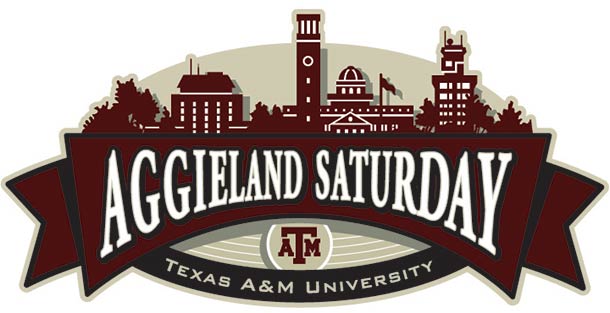Aggieland Saturday visitors to learn what college has to offer

Visit the Texas A&M Aggieland Saturday [website] (http://admissions.tamu.edu/aggielandsaturday/) .
The College of Architecture hosted prospective students and their parents as part of Texas A&M's Feb. 16, 2013 [Aggieland Saturday] (http://admissions.tamu.edu/aggielandsaturday/) festivities at venues across the Texas A&M campus.
Aggieland Saturday visitors met current students and faculty, toured dormitories, visited libraries and labs and learned what Texas A&M has to offer.
The College of Architecture hosted a full slated of activities at the [Langford Architecture Center] (http://www.arch.tamu.edu/inside/getting-here/) . To facilitate visitors, the college offered two welcome sessions in the Preston Geren Auditorium; Additionally, administrators and faculty from the college's four departments — architecture, construction science, landscape architecture and urban planning and visualization — provided two morning information sessions and one afternoon information session. The department sessions provided details on the departments' degree offerings and potential careers in the disciplines. A corresponding session focused on the University Studies option offered through the college.
Other activities included student-led tours of college facilities, student organization booths and a noontime hot dog lunch.
About the College of Architecture
One of the premier design research institutions in the world, the College of Architecture at Texas A&M University offers an energetic environment for academic and professional success through a comprehensive catalog of prominently ranked graduate and undergraduate programs in architecture, landscape architecture, urban planning, construction science, land development and visualization.
The college is a haven for experimentation, discovering one’s strengths and unleashing the hidden capabilities of the human mind. Here students embark on a journey of self-discovery. They learn how to unlock their creative potential, become lifelong learners, intellectual leaders and knowledge creators.
The college is literally abuzz with creativity around the clock as its 1,900 students, 140 faculty and 59 professional staff engage in myriad design and multimedia projects focused on the transformation of the human environment. Space is in constant motion as students collaborate and concepts take form in sketches, paintings, computer simulations, models, photographs, sculptures and video.
Architectural installations and artwork are regularly erected, studied and deconstructed. The walls are papered with an ever-changing mosaic of project posters that are pinned up, rigorously reviewed, and taken down to make room for next review.
While some students study alone in private nooks, computer labs or the college’s reference library, others collaborate in studios, classrooms or the coffee shop. There are lectures, seminars, workshops, design charrettes, exhibits, concerts, film screenings, celebrations and special events — many planned and many impromptu.
A cacophony of busy power tools and sophisticated machinery echoes from the college’s woodshop where architectural models, furniture, artwork and special projects take shape. On the nearby prairie, the whirl and hum of a CNC router and plasma cutter denote more substantial structures in the works at the college’s 12-acre Digital Fabrication Facility, referred to affectionately by students as the “Architecture Ranch.”
Because the creativity and empathy with which each discipline is practiced has a profound influence on the quality of life in society, College of Architecture students are challenged to weave aesthetics, safety, function, financial feasibility, sustainability and environmental stewardship into the creative process.
Recognizing that no single professional track or narrow specialization can adequately prepare tomorrow’s building, design, planning and visualization professionals, the college is distinctive in offering a truly interdisciplinary curriculum. As one of the largest schools of its kind, housing all of the built environment disciplines, the college is uniquely suited to facilitate interdisciplinary collaboration and research.
Its rich and diverse research portfolio includes projects conducted in its four academic departments, through its multiple institutes, research centers and specialized laboratories, and in collaboration with other colleges and centers within the university and around the world. The college’s Institute for Applied Creativity and five formally organized research centers — the CRS Center for Leadership and Management in the Design and Construction Industry, the Center for Housing and Urban Development, the Hazard Reduction and Recovery Center, the Center for Health Systems & Design, and the Center for Heritage Conservation — expand the public knowledge base of the industries and professions they serve while supporting specialized graduate certificate programs.
And because we all live in a highly interconnected world, those pursuing an undergraduate degree at the college are required to spend a long semester away from Texas A&M University’s College Station campus, either engaged in a professional internship or studying abroad in one of the college’s well-established programs in Italy, Spain, Germany, the United Kingdom or elsewhere.
Tags
- academics
- architecture
- college culture
- construction science
- events
- feature
- landscape architecture & urban planning
- outreach
- visualization
Related Posts
Camps offer kids intro to disciplines taught at college

Nominations for outstanding college alumni due March 1

Students visualize data, win prizes at Build Day contest

College names eight Outstanding Alumni
Follow Us
Facebook Twitter Vimeo Youtube Flickr RSS
Recent Posts

Planning prof heads study of disaster housing aid

A message from the dean

Former student remembered as expert planner

Leading educator named new head of Architecture Dept.






_thumbnail_small.png)
